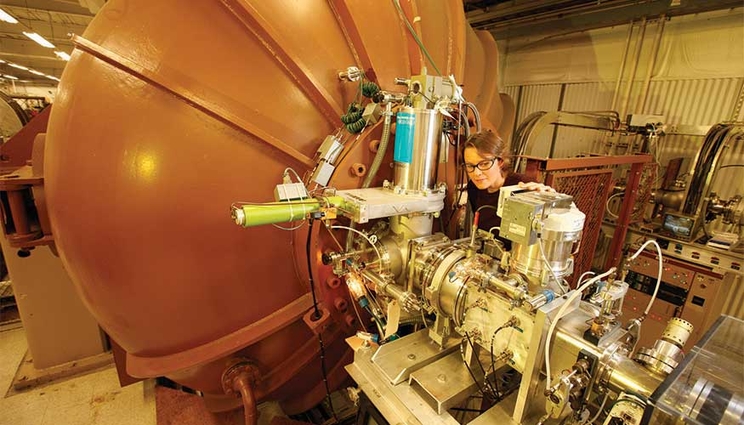Carbon dating impacts non-proliferation, drug research and climate change
Here is a sampling of some of the many ways CAMS is utilized, along with the important discoveries scientists have made using the facility during its first 25 years.
Biological research
The first biological AMS research conducted at CAMS in 1990 starts a brand new field that encompasses basic biological research, drug therapy development and bio-14C forensics.
Heavy element research
- New therapies for heart disease, neurological damage and Alzheimers may be based on carbon 14 (14C) analyses that determine how long individual cells live in a human body before being turned over and/or repaired.
- In an effort to identify the thousands of John/Jane Doe cold cases in the United States, CAMS is used to help identify the remains of missing persons by dating hair and teeth to determine time of death.
- 14C analyses of anthrax assist the FBI in developing the first leads in the 2001 case.
- In the late 1990s researchers begin 14C dating elephant tusks to determine whether the animal died before the 1989 international ban on ivory sales or was killed after the ban went into effect. The research distinguishes legal (pre-1989) ivory from poached (post 1989).
Meeting programmatic needs for the nation, 'heavy' element AMS is used for radiochemical assessments, non-proliferation, geochemistry and other related applications.
- Researchers affirm radiation data from Hiroshima and Nagasaki, which serve as the world's primary basis for estimating radiation-induced cancer risk in humans.
- Ultra-low level isotope measurements used for radiological assessments have assisted the re-settlement of the Marshall Islands.
- Researchers track a rare isotope of iodine (129-I) from the Dai-ichi Nuclear Power Plant disaster in the ocean for radionuclide release estimates, dose reconstruction and use the 129I as a 'dye tracer' to study ocean circulation.
Research in the earth sciences uses a number of different isotopes and places rates, timing and duration to landscape altering processes across the span of geologic time. Related applications include the basic age control on events and time series of, for example, climate variability in the past.
- Researchers have collaboratively worked on how frequently earthquakes occur, including proof of principle work to develop reconstructions of seismic events in coastal sequences.
- Long and short term rates of erosion and development of soils and related sedimentary facies.
- Landscape scale deformation and seismic reconstruction of extreme landscape altering events using precariously balanced boulders.
- Kennewick man, Captain Picard's ancient doppleganger, one of the oldest and most complete early North American humans is dated to 9,300-9,600 years BC.
Researchers study the fate and transport of carbon in the earth system and the intersection of the carbon cycle and climate to better predict climate change.
- Storage of carbon in below ground soils is a complex interaction between input (leaf litter and woody debris, roots and root exudates), microbes that "eat" inputs and mineral surfaces that help complex carbon containing compounds and 'sequester' them for decades to millennia.
- Attribution and detection to precisely determine the amount of carbon dioxide produced from the combustion of fossil fuels.
- Understanding the uptake and redistribution of anthropogenic carbon in the ocean and how to better model future uptake and ocean circulation under rising atmospheric CO 2 concentrations and climate change.
Contact
Anne M Stark[email protected]
925-422-9799
Related Links
Lawrence Livermore celebrates 25 years of carbon datingTags
Center for Accelerator Mass SpectrometryUser Facility
Physical and Life Sciences
Energy
Science
Featured Articles









